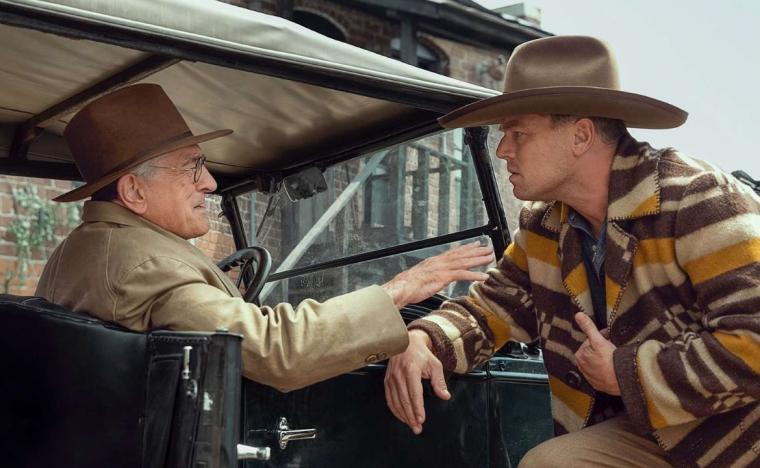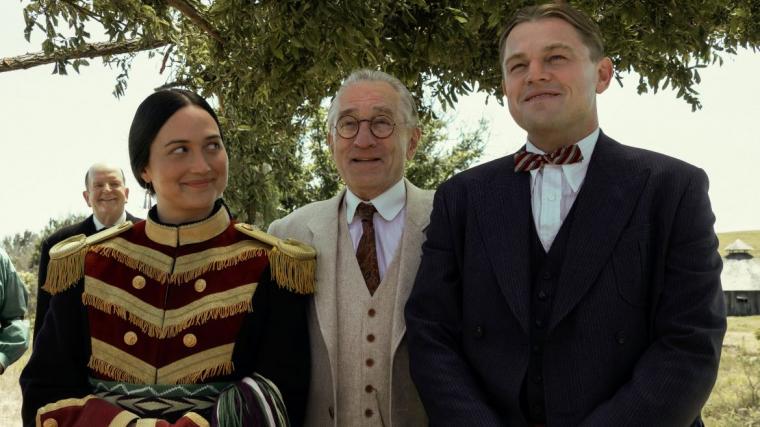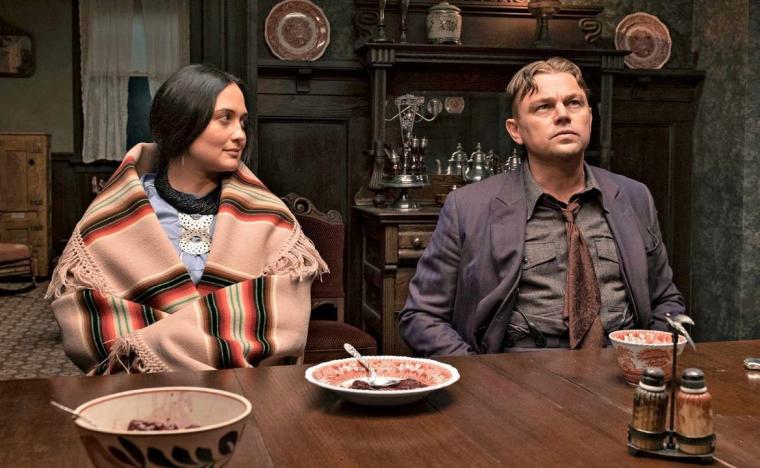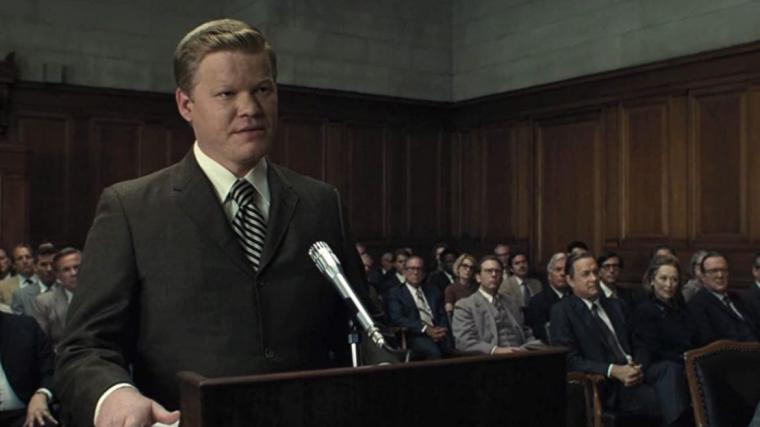
Robert De Niro and Leonardo DiCaprio in Killers of the Flower Moon
KILLERS OF THE FLOWER MOON
It's routinely said that what matters isn't the actual length of a movie, but rather how long a movie feels. Killers of the Flower Moon, Martin Scorsese's genre-blending tale of systemic murder set in early-20th-century Oklahoma, runs just slightly under three-and-a-half hours. Unlike Scorsese's 2019 The Irishman, however, which lasted about five minutes longer, his latest epic crime drama feels like three-and-a-half hours.
This isn't always a detriment; the subject matter alone makes a case for the expansiveness, and this gorgeously produced and executed work is teeming with pleasures both minor and massive. But the narrative repetition, which is arguably part of the film's point, is still a little wearying, and Scorsese's and co-screenwriter Eric Roth's decision to make one of their two main figures an (intentional) empty suit seemingly incapable of insight and independent thought doesn't do the run time any favors, even with – maybe especially with – Leonardo DiCaprio in the role. Don't get me wrong: I liked Killers of the Flower Moon. Parts of it I actively loved. Yet at present, I'd argue that the material would've played better at either half its length (with more fearsome momentum and rage) or twice its length (as a six-part limited series that could've delivered a few standout set pieces amid each episode's character focus). You'll get your money's worth and then some here. If only “then some,” in this case, didn't essentially mean “opportunities for a quick nap.”
The year is 1918, and DiCaprio's World War I veteran Ernest Burkhart has newly arrived in Fairfax, Oklahoma, to work for his uncle, the cattle rancher William “King” Hale (Robert De Niro). Fairfax has recently become a wildly prosperous city due to the vast reserves of oil under Osage Nation land – acreage the Native Americans were unceremoniously relocated to and bequeathed by the federal government, which had no notion of its potential value. Although the denizens are now the wealthiest people around – some of the wealthiest people in the United States – and the city is thriving, it's unclear what, precisely, Ernest plans to do in Fairfax. He has no experience in the herding of cattle, few other skills to speak of (we learn that Ernest spent his combat-free military tenure as a cook), and no clear plan for himself. All we do know, based on Ernest's initial interview with his uncle, is that the young man wants to (a) get rich, and (b) get laid – the precise combination King is looking for. A showy “friend” to the Osage who even speaks their language, King and his minions secretly want nothing more than to separate the Native Americans from their riches and their land. How would Ernest feel, King asks, about working as a cab driver, and possibly wooing and wedding the Osage Mollie Kyle (Lily Gladstone), a diabetic whose property, in the event of her death, would automatically fall to Ernest?

I should add a caveat to that “automatically,” because it's not merely Mollie who would have to die for Ernest to legally inherent her fortune. So would all of her living relatives: parents, siblings, and, in the event she has them, children. Such is the hideous context for the murders continually perpetuated in Killers of the Flower Moon, with King too charming and sociable to be seen as the monster he is, and Ernest too weak-willed and shapeless to do anything but cater to his uncle's wretched scheme. The only hitches in King's plan are that Ernest, in his courtship and eventual marriage, falls deeply in love with Mollie, and Mollie, despite knowing better (“Coyote wants money” she says to Ernest with a teasing half-smile), falls deeply in love with him. Given the casting, Ernest's ardor is completely understandable. Mollie's, alas, is less so.
Aside from the vital, long-overdue history lesson provided, Lily Gladstone is the hands-down-best reason to see Scorsese's opus. Radiantly watchful (and watchable), her Mollie is only occasionally employed to exemplify the stalwart decency of the besieged Osage people. At least early on, this woman is shrewd, funny, self-assured, and of no temperament to suffer fools, and Gladstone makes Mollie remarkably vivid despite the majority of her screen time requiring her to either suffer near-operatic sorrow or descend into further and further states of emotional and physical disintegration. The movie is based on David Gann's celebrated 2017 nonfiction, a book whose central figure is both a figurative and literal White Savior: Tom White, the pre-FBI Bureau of Investigation agent who ultimately cracked the Osage-massacre case. White is played in the film, with gentility and polite determination, by the reliably excellent Jesse Plemons. Yet the role is basically an extended cameo, and it was wise, I think, of Scorsese and Roth to instead opt to spotlight Mollie – not just because of the rich connection it gives us to the Osage and their plight, but because the weight of their struggle is so effectively communicated in Gladstone's eyes and bearing. She's extraordinary in Killers of the Flower Moon, and through no fault of her own, my one ding on her performance is that she isn't able to fully sell Mollie's adoration of Ernest. I'm not sure that anyone could.
Leonardo DiCaprio is the damnedest actor. He's unquestionably skillful, and at odd moments throughout his most recent of six collaborations with Scorsese – particularly when Ernest, in a long unbroken take, demonstrates his spinelessness on the witness stand – DiCaprio is sensational; it's evident that he wants to give himself over to the role. Yet whenever he's cast as fundamentally dumb or heinous characters, the guy can't stop telegraphing, essentially telling us “That's him, not me.” This works to DiCaprio's advantage in comedy; part of the fun of his Wolf of Wall Street and Once Upon a Time … in Hollywood turns lies in the showboating joy he's obviously taking in playing outsize heels and lunkheads. When enacting more dramatically put-upon, despicable, or tragic figures, however, DiCaprio keeps resorting to performance italicization and surface-level tricks: in this case, an eternally furrowed brow, a frown that resembles a capital-letter “C” at a rightward 90-degree angle, and a backwoods twang that doesn't make sense for the character but might've been cozily familiar, given that it's the exact same accent he employed for Tarantino in 2019. (There, at least, Rick Dalton's twang was comically beneficial.)

At 48, DiCaprio still looks boyish enough to reasonably pass as a 20-something WWI veteran – even if it is distracting every time the 13-years-his-junior Plemons calls Ernest “son,” as he does on at least a dozen occasions. (To be fair, DiCaprio's age-inappropriate casting is less nutty than the idea of Ray Liotta playing a 20-year-old in the early scenes of GoodFellas, and I'm grateful that Scorsese chose to forego the de-aging effects that were a source of such contention in The Irishman.) The actor also develops a fairly convincing romantic rapport with Gladstone – and Mollie liking Ernest makes us like him more. But like De Niro's Irishman Frank Sheeran, Ernest is a fundamentally compliant, vacuous, and, I hate to say it, uninteresting figure, and while I'm delighted that Scorsese's reworking of Gann's nonfiction led to greater focus on Mollie, her sap husband isn't equally engaging company over more than 200 straight minutes. Ernest was told what to do, and he did it, and he felt mildly guilty about it – this went on and on until I was practically begging for some fresh shadings, and for DiCaprio to offer even one line reading with any spontaneity or surprise. He may be giving Scorsese just what the director wanted, but all told, this is an achingly dull performance, and its sameness merely exacerbates the movie's formidable length.
Almost across the board, Scorsese's other actors fare a lot better. I'm temped to say that De Niro hasn't been this good since GoodFellas. One of the more unconscionable aspects to the Osage massacre, at least in Scorsese's telling, is how nonchalant the greedy whites were about the systematic execution of dozens (perhaps hundreds) through gunfire, poisoning, or, in one notable example, an explosion that blew out the windows of houses several blocks away. De Niro takes this conceit and positively goes to town with it, his malevolent rancher the very picture of grinning, generous decorum until the smile drops and his inner demon is revealed. In one of Flower Moon's most memorable sequences, the actor's land baron maliciously belittles and bullies his nephew on a black-and-white floor that resembles a chess board – the difference being that, as opposed to a chess match in which the king requires protection, this King is the attacker.
De Niro and Gladstone would be more than enough for a viewing even beyond this Scorsese's typically superb creative team, with Rodrigo Prieto Flower Moon's cinematographer, The Band's Robbie Robertson its composer, and the director's longtime partner-in-crime-flicks Thelma Schoonmaker its editor. (The film's exorbitant run-time is hardly reflective of Schoonmaker's gifts, to say nothing of a knock on her editing prowess with the tonnage of footage assembled here.) Yet as generally happens with a two-plus-hour Scorsese – and I don't think there's been a less-than-two-hour Scorsese since the '80s – even the casting of the most minor roles provides a mostly joyous jolt.

Granted, the Oscars' reigning Best Actor champ Brendan Fraser is overscaled and monotonous in his brief role as a defense attorney, and I wish that John Lithgow, as the opposing counsel, had more to do than his “just the facts, ma'am” appearance allowed. Yet their underwhelming contributions are easily ignored in the face of so much inspiration elsewhere, such as the genius participation of country-music star Jason Isbell as a subtly, unexpectedly fierce Ernest combatant; Cara Jade Myers as Mollie's bawdy, drunken sister Anna; the great Barry Corbin as a zealous undertaker; Gene Jones (one of the few whom Javier Bardem let live in No Country for Old Men) as a long-faced Halifaxian; and, perhaps most creepily, Louis Cancelmi as King's accomplice Kelsie Morrison. Inquiring as to whether he would inherit his deceased bride's money if he adopted her kids, the man is sternly reprimanded for making it sound as though he was planning to murder those children for the payout. Morrison's unashamed reply: “Well, not if I'm not getting the money I won't.”
It's this sort of blasé acknowledgment of abhorrent white privilege that fuels Killers of the Flower Moon, and that also accounts for some of its tedium. The film is hardly wall-to-wall death: the Ernest/Mollie romance involves a lot of screen time (maybe more than some of us would have preferred); there are numerous segments – and a spectacular climactic image – involving the Osage with no interference from Caucasians; the sickly Mollie establishes herself as the movie's unquestioned moral center when she takes a surprisingly productive trip to Washington D.C. to beg the aid of President Calvin Coolidge. But for all of its considerable strengths, the narrative redundancy and insufficient male lead of Scorsese's latest makes this a just-miss of a masterpiece, despite boasting what might be the most phenomenal, presentationally ballsy finale of its creator's career, and a finale featuring one of the most moving, thematically apt cameos in recent American movies. I'm only sorry it took almost 200 minutes to land.








